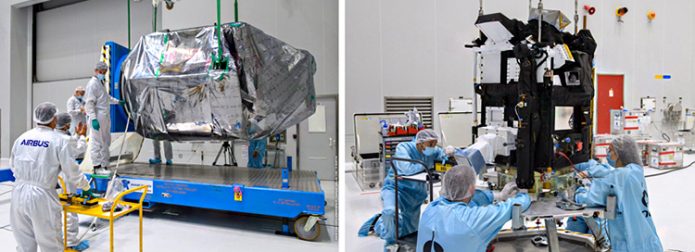Spain’s SEOSAT-Ingenio (at left) is readied for the startup of its checkout process in the Spaceport’s S5 payload preparation facility, which will begin after the external wrapping is removed. In parallel, the French Taranis scientific satellite (at right) undergoes an initial inspection in another of the S5 clean room areas.
October 1, 2020
Arianespace’s next Vega mission will orbit passengers with two very different perspectives: Spain’s SEOSAT-Ingenio high-resolution optical imaging platform, which is to monitor the Earth for civil and military uses; and the French Taranis microsatellite, to observe the mysterious atmospheric emissions that occur above thunderstorms.
Both spacecraft arrived in French Guiana last week, delivered by a chartered Antonov AN-124 cargo jetliner that touched down at Cayenne’s Félix Eboué Airport. They were transported by road to the Spaceport, where processing is now underway in separate clean room areas of the S5 payload processing facility.
The Vega’s mission with these satellites is designated Flight VV17 in Arianespace’s launcher family numbering system, and is scheduled for liftoff in November.
SEOSAT-Ingenio: Spain’s optical observation satellite
Arianespace’s launch services contract for the SEOSAT-Ingenio satellite was signed with the European Space Agency (ESA) for Spain’s CDTI (Center for Development of Industrial Technology). SEOSAT-Ingenio is the first Spanish satellite with optical technology, developed primarily by the Spanish space industry with Airbus in Spain as the prime contractor. Its liftoff mass will be approximately 840 kg.
High-resolution imagery from SEOSAT-Ingenio is to be used for civil and military purposes in such applications as security, land management, natural resources, border surveillance, agriculture and natural disaster crisis management. This strategic satellite for Spain is owned by the Spanish Ministry of Science and Technology, with the CDTI leading the spacecraft project by delegation and also assuming its cost.
Taranis: Studying the phenomena above thunderstorms
The other passenger on Vega Flight VV17 is Taranis, named after the god of thunder in Celtic mythology, and the satellite’s designation is an acronym of: Tool for the Analysis of RAdiation from lightNIng and Sprites. Taranis will study impulsive transfers of energy between the Earth’s atmosphere and the space environment that occur above thunderstorms.
Funded by the French CNES space agency, this satellite will have a liftoff mass in the 200-kg. category and is to provide data on the transient luminous events that have been observed in the past 30 years, particularly such phenomena that are called sprites, jets and elves.
Both SEOSAT-Ingenio and Taranis will operate in similar orbits at an altitude of approximately 700 km. In ride-sharing this launch on Arianespace’s light-lift Vega launcher, the two spacecraft will be deployed by a VESPA payload dispenser, produced by Airbus in Spain for Avio.

